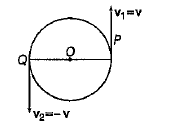A particle is moving with a constant speed in a circular path. Find the ratio of average velocity to its instantaneous velocity when the particle rotates an angle θ=(π2) .
The correct Answer is:B
To solve the problem of finding the ratio of average velocity to instantaneous velocity for a particle moving in a circular path, we will follow these steps:
Step 1: Understand the Motion
The particle is moving in a circular path with a constant speed and rotates through an angle of θ=π2 radians (90 degrees). This means the particle moves from point A to point B along a quarter of the circular path.
Step 2: Identify the Points
Let:
- O be the center of the circular path.
- A be the initial position of the particle.
- B be the position of the particle after rotating through π2.
Step 3: Determine the Displacement
The displacement AB can be calculated using the geometry of the situation. Since the particle moves from A to B, which are at right angles to each other, we can form a right triangle:
- The radius OA=R (where R is the radius of the circular path).
- The length OB=R.
Using the Pythagorean theorem:
AB=√OA2+OB2=√R2+R2=√2R2=R√2
Step 4: Calculate the Average Velocity
The average velocity Vavg is defined as the total displacement divided by the time taken. The time taken to move through a quarter of the circular path is T4, where T is the time for a complete revolution.
The average velocity can be calculated as:
Vavg=ABtime=R√2T4=4R√2T
Step 5: Calculate the Instantaneous Velocity
The instantaneous velocity Vinst is defined as the speed of the particle at any point in time. For a complete revolution, the instantaneous velocity can be calculated as:
Vinst=CircumferenceTime=2πRT
Step 6: Find the Ratio of Average Velocity to Instantaneous Velocity
Now, we need to find the ratio of average velocity to instantaneous velocity:
Ratio=VavgVinst=4R√2T2πRT=4R√22πR
After simplifying, we get:
Ratio=4√22π=2√2π
Final Answer
The ratio of average velocity to instantaneous velocity when the particle rotates an angle θ=π2 is:
2√2π
The particle is moving in a circular path with a constant speed and rotates through an angle of θ=π2 radians (90 degrees). This means the particle moves from point A to point B along a quarter of the circular path.
Let:
- O be the center of the circular path.
- A be the initial position of the particle.
- B be the position of the particle after rotating through π2.
The displacement AB can be calculated using the geometry of the situation. Since the particle moves from A to B, which are at right angles to each other, we can form a right triangle:
- The radius OA=R (where R is the radius of the circular path).
- The length OB=R.
AB=√OA2+OB2=√R2+R2=√2R2=R√2
The average velocity Vavg is defined as the total displacement divided by the time taken. The time taken to move through a quarter of the circular path is T4, where T is the time for a complete revolution.
Vavg=ABtime=R√2T4=4R√2T
The instantaneous velocity Vinst is defined as the speed of the particle at any point in time. For a complete revolution, the instantaneous velocity can be calculated as:
Vinst=CircumferenceTime=2πRT
Now, we need to find the ratio of average velocity to instantaneous velocity:
Ratio=VavgVinst=4R√2T2πRT=4R√22πR
Ratio=4√22π=2√2π
The ratio of average velocity to instantaneous velocity when the particle rotates an angle θ=π2 is:
2√2π
Topper's Solved these Questions
- BOOK - DC PANDEYCHAPTER - CIRCULAR MOTIONEXERCISE - Exercise 10.27videos
CIRCULAR MOTION
- BOOK - DC PANDEYCHAPTER - CIRCULAR MOTIONEXERCISE - Exercise 10.34videos
CIRCULAR MOTION
- BOOK - DC PANDEYCHAPTER - CIRCULAR MOTIONEXERCISE - Miscellaneous Examples5videos
CIRCULAR MOTION
- BOOK - DC PANDEYCHAPTER - CENTRE OF MASS, LINEAR MOMENTUM AND COLLISIONEXERCISE - Level 2 Subjective21videos
CENTRE OF MASS, LINEAR MOMENTUM AND COLLISION
- BOOK - DC PANDEYCHAPTER - COMMUNICATION SYSTEMEXERCISE - Only One Option is Correct27videos
COMMUNICATION SYSTEM
Similar Questions
Knowledge Check
- Question 1 - Select One
A particle is moving with a constant speed v in a circle. What is the magnitude of average velocity after half rotation?
A2vBv(vπ)Cv2Dv2π - Question 2 - Select One
A particle is moving with a constant speed in a circular orbit. Find the change in its velocity when it completes half the revolution.
 A2vB4vC3vDv
A2vB4vC3vDv - Question 3 - Select One
A particle starts from rest with constant acceleration. The ratio of space-average velocity to the time average velocity is :-
A1/2B3/4C4/3D3/2
When a particle moves with constant velocity, its average velocity, its instantaneous velocityi and its speed are all equal. Comment on this statement.
View SolutionAngular momentum of a single particle moving with constant speed along circular path :
View SolutionA particle moves with uniform speed in a circular path the angle between instantaneous velocity and acceleration is
View SolutionThe magnitude of average velocity is equal to the average speed when a particle moves:-
View Solution
A particle is moving on a circular path of radius r with uniform velocity v. The change in velocity when the particle moves from P to Q is (∠POQ=40∘)View Solution

